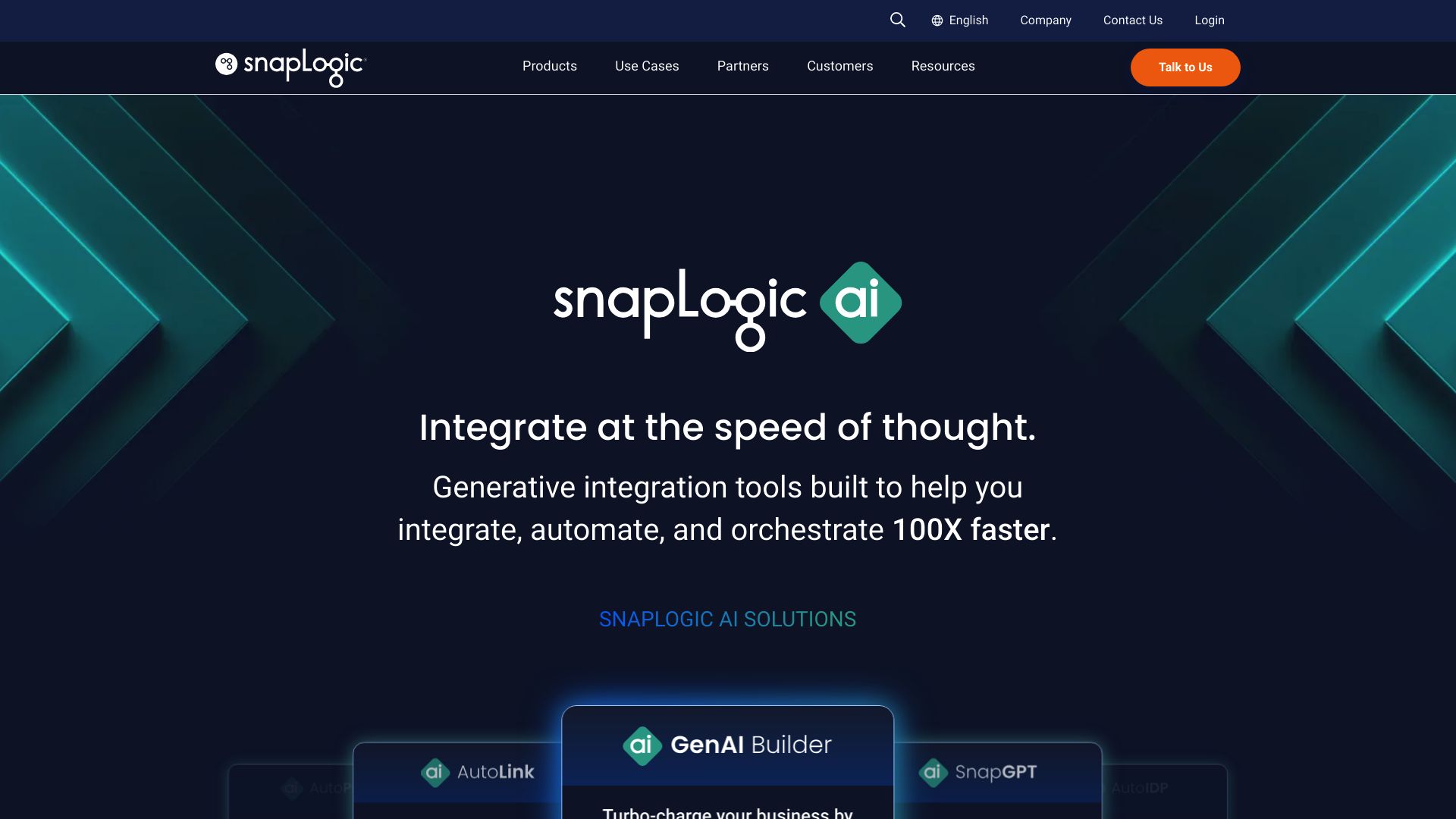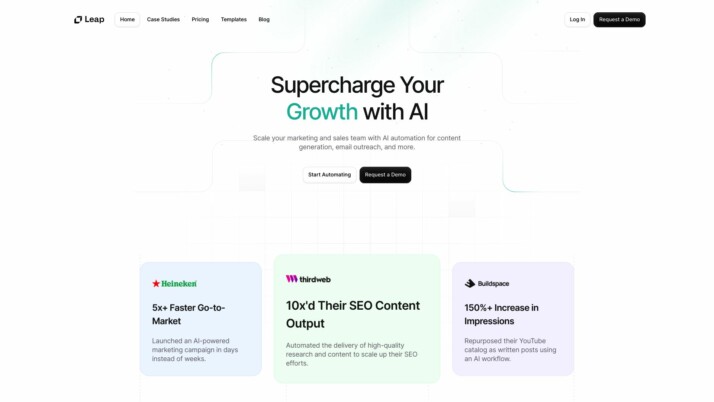snapLogic AI vs. Leap AI: Enterprise Integration or No-Code AI?
AI-powered platforms are transforming how businesses integrate data, automate workflows, and build intelligent applications. This review compares snapLogic AI vs. Leap AI, and SmythOS, three leading platforms in the AI automation space. We’ll explore their key features, strengths, and limitations to help you choose the right solution for your organization’s needs. Whether you’re a developer seeking powerful APIs, a business leader focused on scalability and compliance, or a non-technical user looking for no-code tools, this comparison will provide valuable insights into each platform’s capabilities and potential impact on your AI initiatives.
snapLogic AI Overview
snapLogic AI offers an Intelligent Integration Platform that streamlines data and application integration across cloud and on-premises environments. The platform leverages AI-powered workflows to automate integration tasks, reducing development time and complexity for both technical and non-technical users.


SnapLogic’s platform stands out with its intuitive visual interface and pre-built connectors called “Snaps.” These features enable users to create complex data pipelines and integrations without extensive coding. The AI-driven approach, exemplified by tools like SnapGPT and the Iris AI technology, provides intelligent suggestions and automates repetitive tasks, further simplifying the integration process.
SnapLogic’s platform stands out with its intuitive visual interface and pre-built connectors called “Snaps.” These features enable users to create complex data pipelines and integrations without extensive coding.
The platform excels in scalability, leveraging cloud infrastructure to handle enterprise-level workloads. It supports a wide range of data types and integration scenarios, from batch processing to real-time streaming. SnapLogic also emphasizes security and compliance, offering features like data encryption and audit logging to meet enterprise requirements.
While SnapLogic offers powerful capabilities, users may face challenges in certain areas. The platform’s extensive feature set can have a steep learning curve for beginners. Additionally, while the visual interface simplifies many tasks, advanced customizations may still require technical expertise. The pricing model, which is not publicly disclosed, may also be a consideration for smaller organizations or individual developers.
SnapLogic’s vision focuses on democratizing integration and accelerating digital transformation. By combining AI-powered automation with user-friendly tools, the platform aims to empower a broader range of users to tackle complex integration challenges. This approach positions SnapLogic as a solution for organizations looking to streamline their data ecosystems and drive innovation through efficient, AI-enhanced integration processes.
Leap AI Overview
Leap AI empowers users to create sophisticated AI workflows without coding expertise. The platform’s no-code visual builder allows rapid development of AI-powered applications, from chatbots to content generators. Leap AI integrates with popular AI models like OpenAI GPT and Stable Diffusion XL, offering versatility for various tasks.


Screenshot of Leap AI Website
The platform shines in its extensive template library, providing ready-made solutions for common AI applications. Users can quickly deploy AI agents for blog writing, music generation, or sales lead summarization. Leap AI’s SDK support, including RESTful API, TypeScript, and Python, ensures seamless integration into existing systems.
Leap AI empowers users to create sophisticated AI workflows without coding expertise. The platform’s no-code visual builder allows rapid development of AI-powered applications, from chatbots to content generators.
Leap AI’s strength lies in its accessibility and integration capabilities. The platform connects effortlessly with tools like Slack, Hubspot, and Zapier, enabling AI-enhanced workflows across multiple business functions. While powerful, Leap AI may require some learning for users to fully leverage its capabilities across diverse use cases.
Leap AI focuses on democratizing AI technology, making advanced capabilities accessible to a broader audience. The platform allows users to train and fine-tune custom AI models, enhancing the specificity of outputs for unique business needs. This feature, combined with the no-code approach, positions Leap AI as a versatile tool for businesses looking to incorporate AI into their operations without significant technical overhead.
Leap AI focuses on democratizing AI technology, making advanced capabilities accessible to a broader audience.
In the competitive landscape of AI platforms, Leap AI stands out for its user-friendly interface and rapid deployment capabilities. However, users seeking highly specialized or complex AI implementations may find the platform’s no-code approach limiting in some scenarios. Leap AI’s vision of accessible AI aligns well with the growing demand for AI solutions across industries, making it a noteworthy contender in the AI agent builder market.
Feature Comparison
snapLogic AI and Leap AI offer contrasting approaches to AI-powered automation and integration. snapLogic AI excels in enterprise-grade data integration, leveraging AI to streamline complex workflows across cloud and on-premises environments. Its robust platform includes features like SnapGPT for natural language interactions and a comprehensive set of pre-built connectors called Snaps. snapLogic AI’s strength lies in its scalability and ability to handle large-scale data processing tasks.
Leap AI, on the other hand, focuses on democratizing AI application development with its no-code visual builder. While snapLogic AI targets enterprise-level integrations, Leap AI caters to a broader audience, including non-technical users seeking to create AI-powered workflows quickly. Leap AI’s platform shines in its extensive template library and support for various AI models, making it accessible for rapid prototyping and deployment of AI applications.
A significant feature gap exists in their approach to security and compliance. snapLogic AI offers enterprise-level security features, including data encryption, OAuth support, and IP control, which are crucial for handling sensitive data in regulated industries. Leap AI’s documentation does not explicitly highlight such robust security measures, potentially limiting its appeal for organizations with stringent data protection requirements. Additionally, snapLogic AI’s ability to integrate with data lakes and support for various file formats gives it an edge in handling diverse data sources, a capability not prominently featured in Leap AI’s offerings.
Feature Comparison Table
| snapLogic AI | Leap AI | SmythOS | |
|---|---|---|---|
| CORE FEATURES | |||
| Hosted Agents (Dev, Production) | ✅ | ❌ | ✅ |
| Memory & Context | ❌ | ✅ | ✅ |
| Autonomous Agents | ✅ | ❌ | ✅ |
| Explainability & Transparency | ✅ | ❌ | ✅ |
| Debug Tools | ✅ | ❌ | ✅ |
| Multi-Agent Collaboration | ✅ | ❌ | ✅ |
| SECURITY | |||
| Constrained Alignment | ✅ | ❌ | ✅ |
| COMPONENTS | |||
| Foundation AIs | ❌ | ✅ | ✅ |
| Huggingface AIs | ❌ | ✅ | ✅ |
| Zapier APIs | ❌ | ✅ | ✅ |
| Classifiers | ❌ | ✅ | ✅ |
| Data Lakes | ✅ | ❌ | ✅ |
| DEPLOYMENT OPTIONS (EMBODIMENTS) | |||
| Staging Domains | ❌ | ✅ | ✅ |
| Production Domains | ❌ | ✅ | ✅ |
| Deploy as Site Chat | ❌ | ✅ | ✅ |
| Deploy as GPT | ❌ | ✅ | ✅ |
| DATA LAKE SUPPORT | |||
| Hosted Vector Database | ❌ | ❌ | ✅ |
| Sitemap Crawler | ❌ | ✅ | ✅ |
| YouTube Transcript Crawler | ❌ | ✅ | ✅ |
| URL Crawler | ❌ | ✅ | ✅ |
Best Alternative to snapLogic AI and Leap AI
SmythOS stands out as the superior alternative to snapLogic AI and Leap AI, offering a comprehensive platform for AI agent development and deployment. We combine the best of both worlds: snapLogic AI’s enterprise-grade capabilities and Leap AI’s user-friendly approach, while addressing their limitations.
Our platform excels in ease of use, boasting a powerful drag-and-drop interface that makes AI agent creation accessible to both technical and non-technical users. This visual builder surpasses Leap AI’s no-code tools, offering greater flexibility and customization options without sacrificing simplicity.
SmythOS’s feature set is unparalleled. We support a wide array of AI models, including those from OpenAI, Anthropic, and Hugging Face, providing users with more choices than either snapLogic AI or Leap AI.
SmythOS’s feature set is unparalleled. We support a wide array of AI models, including those from OpenAI, Anthropic, and Hugging Face, providing users with more choices than either snapLogic AI or Leap AI. Our platform enables the creation of autonomous agents capable of complex problem-solving and multi-agent collaboration, features not prominently available in the competitors’ offerings.
Unlike snapLogic AI and Leap AI, SmythOS offers unlimited use cases. From chatbots and API deployments to scheduled agents and GPT integrations, our platform adapts to diverse business needs. We provide robust tools for debugging, monitoring, and scaling AI solutions, ensuring that projects can grow seamlessly from prototype to production.
Security and compliance are top priorities for SmythOS. We incorporate enterprise-grade security features like data encryption, OAuth support, and IP control, addressing the limitations in Leap AI’s security offerings. Additionally, our platform’s ability to integrate with data lakes and support various file formats gives us an edge in handling diverse data sources, a capability not prominently featured in either competitor’s platform.
Conclusion
SnapLogic AI and Leap AI offer distinct approaches to AI-powered automation, each with its own strengths. SnapLogic AI excels in enterprise-grade data integration, providing robust scalability and security features crucial for large-scale operations. Its AI-driven approach, exemplified by tools like SnapGPT, streamlines complex workflows across diverse environments. Leap AI, with its no-code visual builder, democratizes AI application development, making it accessible to a broader audience, including non-technical users.
While both platforms have their merits, SmythOS emerges as the superior choice, offering a comprehensive solution that combines the best of both worlds. Our platform provides enterprise-level security and scalability similar to SnapLogic AI, while maintaining the user-friendly, no-code approach of Leap AI. SmythOS goes further by offering unparalleled flexibility in AI model integration, supporting over 300,000 integrations, and enabling deployment across various environments with our “Create Once, Deploy Anywhere” philosophy.
SmythOS stands out with its advanced features like multi-agent collaboration, comprehensive SDK support, and powerful debugging tools. Our platform’s ability to handle complex AI workflows, combined with its intuitive drag-and-drop interface, makes it suitable for both technical experts and citizen developers. Whether you’re looking to streamline data integration, create AI-powered applications, or deploy sophisticated AI agents, SmythOS provides the tools and capabilities to drive innovation and efficiency in your organization.
To experience the full potential of AI-powered automation and see how SmythOS can transform your workflows, explore our diverse range of AI-powered agent templates. Ready to get started? Create a free SmythOS account and join the AI revolution today. With our 30-day money-back guarantee, you can confidently harness the power of AI to elevate your business processes and drive unprecedented growth.
Last updated:
Disclaimer: The information presented in this article is for general informational purposes only and is provided as is. While we strive to keep the content up-to-date and accurate, we make no representations or warranties of any kind, express or implied, about the completeness, accuracy, reliability, suitability, or availability of the information contained in this article.
Any reliance you place on such information is strictly at your own risk. We reserve the right to make additions, deletions, or modifications to the contents of this article at any time without prior notice.
In no event will we be liable for any loss or damage including without limitation, indirect or consequential loss or damage, or any loss or damage whatsoever arising from loss of data, profits, or any other loss not specified herein arising out of, or in connection with, the use of this article.
Despite our best efforts, this article may contain oversights, errors, or omissions. If you notice any inaccuracies or have concerns about the content, please report them through our content feedback form. Your input helps us maintain the quality and reliability of our information.
